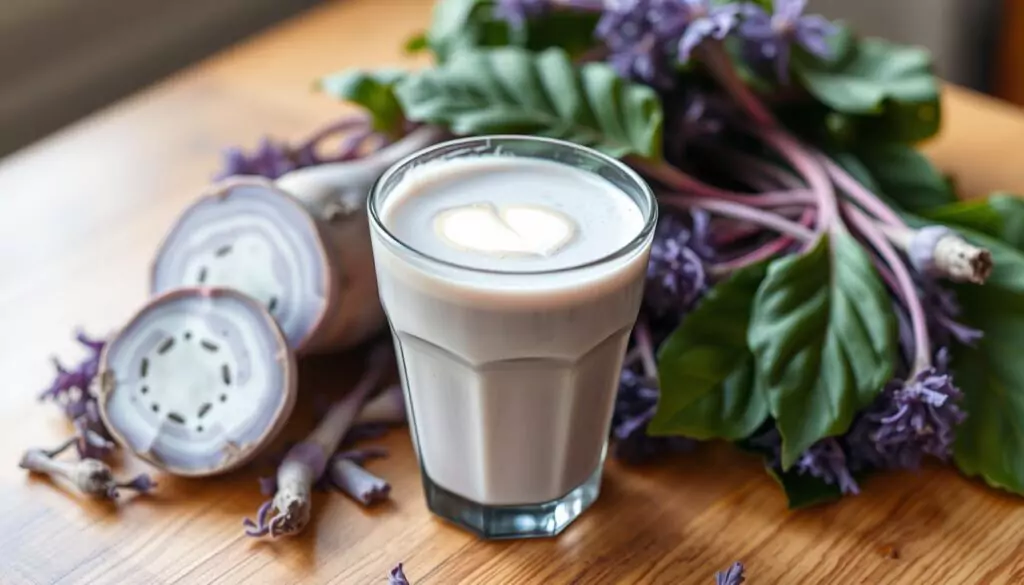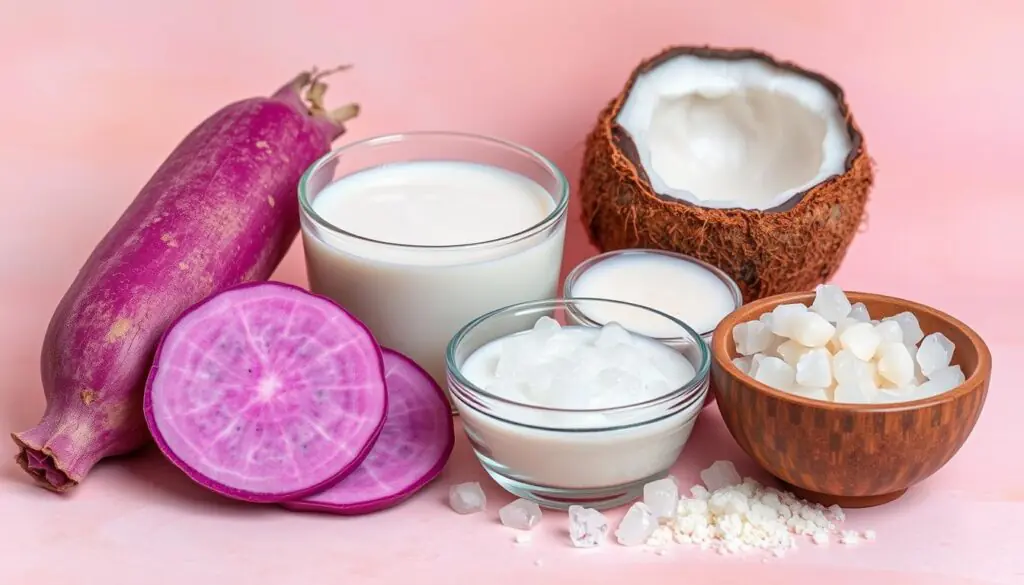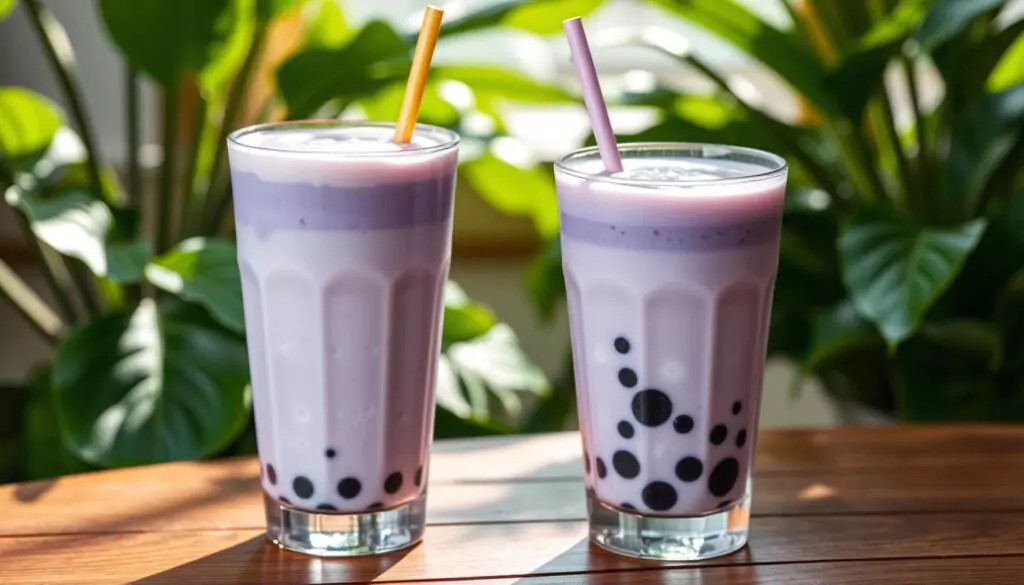As the sun set, casting a warm glow over the city, I yearned for taro milk tea. It’s more than a drink to me; it’s a link to my cultural heritage. It brings to mind the vibrant flavors that have sustained our community for generations.
If you love taro milk tea or are new to Taiwanese drinks, this article is for you. We’ll explore the history, unique tastes, and differences between taro milk tea and taro boba milk tea. Let’s discuss the reasons behind these special drinks.
Table of Contents

Key Takeaways
- Taro milk tea and taro boba milk tea are two popular variations of milk tea that have gained attention in recent years.
- The key differences between the two drinks lie in the presence of tapioca pearls, as well as the texture and mouthfeel.
- Taro milk tea offers a creamy, rich flavor profile, while taro boba milk tea adds the chewy, bouncy texture of tapioca pearls.
- Both beverages have roots in Asian cuisine and have become beloved worldwide as part of the growing bubble tea and milk tea trends.
- Exploring the diverse world of milk tea varieties can be a delightful way to discover new flavors and cultural connections.
What is Taro Milk Tea?
Taro milk tea is a creamy and delightful drink from Taiwan’s tea culture. It uses taro, a starchy root, as its main ingredient. Taro’s purple color and sweet, nutty taste make it different from regular tea.
The History and Origins of Taro Milk Tea
Taro milk tea started in Taiwan’s busy streets. There, tea and new flavors were always being tried. Adding taro to milk tea was a smart move that won hearts worldwide.
The Unique Taro Flavor and Its Appeal
Taro’s flavor is what makes taro milk tea special. It’s sweet, nutty, and earthy, mixing well with milk’s creaminess. This mix creates a tasty and memorable drink. Its bright color also makes it a hit among fans of asian cuisine and Taiwanese drinks.

“Taro milk tea is a delightful fusion of tradition and innovation, capturing the essence of Taiwanese tea culture and elevating it to new heights of flavor.”
Whether you love taro milk tea or are new to beverage trends, this drink will impress you.
The Ingredients in Taro Milk Tea
Taro tea with mil is a favorite drink that mixes taro root’s unique taste with milk’s creaminess and tea’s refreshment. It’s made with a few main ingredients. Let’s explore them:
- Taro Root: The main ingredient, taro root gives the drink its purple color and sweet, nutty flavor. It’s often pureed or powdered to make the drink smooth.
- Milk: Sweetened condensed milk is added to the taro base for a rich, creamy texture. Some variations use almond or soy milk instead.
- Tea: Black or green tea adds a refreshing, aromatic touch to the drink.
- Sugar: A bit of sugar is added to balance the flavors and enhance the taro’s natural sweetness.
These ingredients come together to create milk tea’s unique taste and texture. It’s a favorite among tea lovers and those looking for a comforting drink.
| Ingredient | Purpose |
|---|---|
| Taro Root | Provides the distinctive purple color and sweet, nutty flavor |
| Milk | Adds creaminess and richness to the drink |
| Tea | Contributes a refreshing, aromatic element |
| Sugar | Enhances the natural sweetness of the taro |

“The combination of taro’s distinctive taste and the creamy, comforting qualities of milk tea make it a truly unique and satisfying beverage.”
Taro Milk Tea vs. Taro Boba Milk Tea: Key Differences You Should Know
both have a tasty taro flavor. But, they differ in a big way. The main difference is the presence of tapioca pearls, or boba, in taro boba milk tea. These pearls make the drink special and fun to eat.
The Presence of Tapioca Pearls in Boba Tea
Taro boba milk tea has chewy tapioca pearls. These are cooked and then added to the drink. The boba gives a fun, chewy experience as you enjoy the drink.
The Texture and Mouthfeel Differences
Taro boba milk tea feels different in your mouth than taro milk tea. milk tea is smooth and creamy, like velvet. But, taro boba milk tea is chewier because of the boba. This makes it more fun to drink.
| Feature | Taro Milk Tea | Taro Boba Milk Tea |
|---|---|---|
| Tapioca Pearls | Absent | Present |
| Texture | Smooth, creamy | Chewier, more substantial |
| Mouthfeel | Velvety | Chewy, with a fun, bouncy sensation |

Knowing the differences between taro milk tea and taro boba milk tea helps you choose. You can enjoy the special qualities of each drink.
The Rise of Bubble Tea and Milk Tea Trends
The popularity of bubble tea and milk tea, especially taro-based ones, is growing fast. This is thanks to more people around the world wanting to try Taiwanese cuisine. milk tea and boba milk tea are now favorites in the milk tea world.
The Popularity of Taiwanese Drinks
Bubble tea and milk tea started in Taiwan and have won fans everywhere. These Taiwanese drinks are now a big part of Asian cuisine. They’ve even become popular beyond their cultural roots.
The special flavors and textures of these drinks, like taro milk tea’s creaminess and taro boba’s chewiness, have helped boost milk tea trends. They meet the growing need for beverage trends that bring a taste of the East.
| Bubble Tea Flavor | Popularity Ranking |
|---|---|
| Taro Milk Tea | 1 |
| Matcha Green Tea | 2 |
| Thai Milk Tea | 3 |
| Brown Sugar Boba | 4 |
| Strawberry Milk Tea | 5 |
The bubble tea and milk tea craze is sweeping the globe. The impact of Taiwanese drinks and the Asian cuisine trend is clear.
Variations of Taro Boba Tea and Milk Tea
There’s more to taro milk tea and boba tea than meets the eye. A world of creative variations awaits, catering to all tastes. These new takes on taro flavor let you try different tea bases, sweeteners, and toppings.
The taro latte is a favorite, mixing taro with espresso or steamed milk for a creamy drink. For a special treat, try the taro cheesecake milk tea. It combines taro’s earthy taste with a smooth cheesecake flavor.
- Taro Green Tea Milk Tea: A refreshing mix of taro and green tea’s grassy notes.
- Taro Oolong Milk Tea: Oolong tea’s floral taste pairs well with taro.
- Taro Matcha Milk Tea: Matcha’s vibrant green adds a unique flavor to milk tea.
New beverage trends bring taro-infused milk teas with fun mix-ins. You can find taro boba milk tea with tapioca pearls or milk tea with whipped cream and crushed cookies. These creations show taro’s endless possibilities in milk tea.
“Taro’s unique and comforting flavor profile makes it the perfect ingredient to explore new and exciting milk tea creations.”
If you love taro or want to try new Asian flavors, milk tea and boba tea variations are a must-try. They offer a thrilling journey of flavors and textures.
The Health Benefits of Taro Root
Taro root is key in milk tea and taro boba milk tea. It’s packed with dietary fiber, vitamins, and minerals. This is a wonderful addition to your diet.
Taro’s Nutritional Value and Potential Drawbacks
Taro root is full of good stuff. It has vitamin B6, vitamin C, magnesium, and potassium. It’s also rich in dietary fiber, which aids digestion and blood sugar control. But, it has oxalates too. This might be a problem for those with kidney stones or certain health issues.
| Nutrient | Amount per 100g of Taro Root |
|---|---|
| Calories | 112 |
| Carbohydrates | 27g |
| Dietary Fiber | 4.1g |
| Vitamin B6 | 0.3mg |
| Vitamin C | 2.8mg |
| Magnesium | 29mg |
| Potassium | 487mg |
The health benefits of taro root are well-known. But, it’s important to eat it in moderation. Also, be aware of any sensitivities or dietary restrictions. Always talk to a healthcare professional for advice tailored to you.
The Best Places to Find Authentic Taro Milk Tea
If you love milk tea, finding the real deal is a fun adventure. Many bubble tea shops and places focused on Asian cuisine and Taiwanese drinks serve amazing milk tea.
What makes milk tea authentic is top-notch taro and old-school making methods. These places are proud of their work. They make sure every sip feels like a trip to Taiwanese tea culture.
- Find bubble tea shops known for their milk tea. They use the best taro and make each drink with care, capturing the true taste of this Taiwanese favorite.
- Check out Asian-inspired cafes and restaurants with a wide range of Taiwanese drinks and sweets. They focus on being true to their roots, making them great for finding real milk tea.
- Visit local Asian grocery stores or specialty markets. They often have a section for Taiwanese drinks and ingredients, like milk tea mixes and powders. You can create your own genuine reproduction.
By checking out these places, you can enjoy the deep, creamy, and slightly sweet taste of real taro milk tea. It’s like taking a trip to Taiwan’s lively streets.
Making Taro Milk Tea and Boba Tea at Home
Want to enjoy the tasty flavors of taro milk tea and taro boba milk tea at home? You can! With a few easy steps, you can make your own taro-based milk teas. They’ll taste just as good as those from tea shops.
Taro Milk Tea and Boba Tea Recipe Tips
Here are some tips to make the best milk tea or boba milk tea at home:
- Choose high-quality taro powder or puree for the best taste and color.
- Start with a small amount of sweetener and add more if you like it sweeter.
- For taro boba milk tea, cook the tapioca pearls as the package says for the right chewiness.
- Try different milks like dairy, almond, or oat to find your favorite.
- Add vanilla extract or spices like cinnamon or cardamom to boost the taro flavor.
With a bit of practice and these recipe tips, you’ll soon be enjoying homemade taro boba milk tea and milk tea.
“Making your own milk tea and taro boba milk tea at home allows you to choose the flavors and components that you enjoy”
Exploring the Diverse World of Milk Tea Varieties
The world of milk tea is vast, beyond just milk tea and taro boba. It offers a wide range of choices for those who love tea. You can find everything from traditional black and green tea to new flavors like matcha and oolong. Even cheese-topped milk teas are now available.
Specialty milk tea shops are popping up everywhere. They cater to those who want unique and Instagram-worthy drinks. These shops get creative, adding things like floral essences and fruit purees to their milk teas.
| Milk Tea Variety | Unique Characteristics | Popular Regions |
|---|---|---|
| Jasmine Milk Tea | Aromatic jasmine-infused tea, creamy milk | East and Southeast Asia |
| Oolong Milk Tea | Subtle, floral oolong tea, velvety milk | Taiwan, China |
| Cheese-Topped Milk Tea | Creamy, foamy cheese foam topping | Taiwan, Hong Kong |
| Matcha Milk Tea | Vibrant green tea, frothy milk | Japan, United States |
Bubble tea and Asian cuisine are becoming more popular worldwide. This means the world of milk tea is set to become even more exciting. Tea lovers will have a lot to explore and enjoy.
“The diversity of milk tea flavors and preparations is a testament to the rich cultural heritage and culinary ingenuity of Asian countries.”
The Cultural Significance of Taro and Bubble Tea
Taro is a key ingredient in taro milk tea and taro boba milk tea. It holds deep cultural significance in many Asian cuisines. This starchy root vegetable has been a staple for centuries, used in various dishes.
From savory taro-based curries to sweet taro desserts, it’s a symbol of Asian culinary heritage. Its distinctive purple hue makes it stand out.
The Connection Between Taro and Asian Cuisine
Taro is also connected to the rise of bubble tea, a global phenomenon. The addition of chewy tapioca pearls, or “boba,” to milk tea has made it vibrant and playful. This fusion has made these drinks popular worldwide.
Exploring taro and bubble tea’s cultural context shows their origins and influences. Enjoying milk tea or taro boba milk tea connects you to centuries-old culinary heritage. It also shows the evolving tea culture that has made these drinks beloved globally.
FAQ
What is taro milk tea?
Taro milk tea is a creamy drink from Taiwanese tea culture. It uses taro, a starchy root, for its purple color and sweet flavor. This makes it different from regular black or green milk tea.
What are the ingredients in taro milk tea?
Taro milk tea mixes taro puree or powder, milk, and tea. Sweetened condensed milk and sugar are often added for a creamy taste.
What is the difference between milk tea and boba milk tea?
Taro milk tea and taro boba milk tea both have taro’s unique flavor. But, taro boba milk tea has tapioca pearls for a chewy texture. This texture is missing in regular taro milk tea.
What are the health benefits of taro root?
Taro root is full of fiber, vitamins, and minerals. It may help with digestion and blood sugar. But, it also has oxalates, which some people should avoid.
Where can I find authentic taro milk tea?
You can find real taro milk tea at bubble tea shops. These places focus on Taiwanese and Asian drinks. They use quality taro and traditional methods for the best taste.
Can I make taro milk tea and boba tea at home?
Yes, you can make taro milk tea and boba at home. With the right ingredients and techniques, you can make drinks just like those in tea shops.
What is the cultural significance of taro and bubble tea?
Taro is important in many Asian cuisines. It’s also tied to bubble tea’s global popularity. Learning about taro and bubble tea’s cultural background can deepen your appreciation for these drinks.

